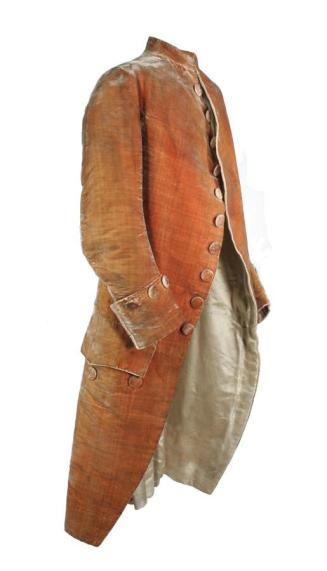Boy's Jacket
Clothing MakerMade by
Unknown
Dateabout 1775-1785
MediumHand-stitched linen, with pewter buttons
DimensionsPrimary Dimensions (center back length x width across shoulders): 27 x 15in. (68.6 x 38.1cm)
Other (sleeve length): 22in. (55.9cm)
Other (waist circumference): 25in. (63.5cm)
ClassificationsCostume
Credit LineMuseum purchase
Object number1981.110.0
DescriptionYouth's jacket made of brown linen, which was probably locally produced. The jacket has a high turn-over collar, and five large pewter shank buttons down the center front opening. The front of the coat is cut with a fashionable curve that sweeps away below the waist. There are two pockets (without flaps) at hip level. The sleeves are narrow, and seamed along the top of the arm as well as underneath to create a curve, ending in approximately two-inch-wide cuffs at the wrist. The body of the coat is cut in four pieces, with a center back seam and two side seams set far to the back. The lower portion of the coat is cut with a flare, controlled by pleats below the side-back seams and ending with a pewter button at both the top and the bottom. The pleats are not open, but tacked at intervals to keep them closed. There is also a deep center back vent. The shoulderline is high, in keeping with the fashionable, slender, narrow-shouldered male silhouette.
Label TextMade of brown homespun linen fabric, this jacket was found in the wall of a house in Guilford, Conn. when the building was undergoing renovation. Although shoes are occasionally found in walls of 18th century homes (a custom that may be connected to folklore or superstitions originating in the British Isles), the dicovery of a full garment is extremely unusual. The coarse, medium-weight fabric was undoubtedly produced locally, perhaps by the wearer's own household, and the pewter buttons may also have been "home-made," as the low melting point of pewter allowed for relatively simple manufacture witha button mold.
The jacket documents the kind of ordinary clothing worn by a working man in the late 18th century; it is a rare survivor, in that garments of this sort were usually worn out, and at the point when they could no longer be repaired, the linen fabric was sold to rag dealers for paper-making. There is obvious wear and some damage to this jacket, however, given its history of use and circumstance of its preservation, it is in surprisingly good condition.
The jacket documents the kind of ordinary clothing worn by a working man in the late 18th century; it is a rare survivor, in that garments of this sort were usually worn out, and at the point when they could no longer be repaired, the linen fabric was sold to rag dealers for paper-making. There is obvious wear and some damage to this jacket, however, given its history of use and circumstance of its preservation, it is in surprisingly good condition.
Status
Not on view









